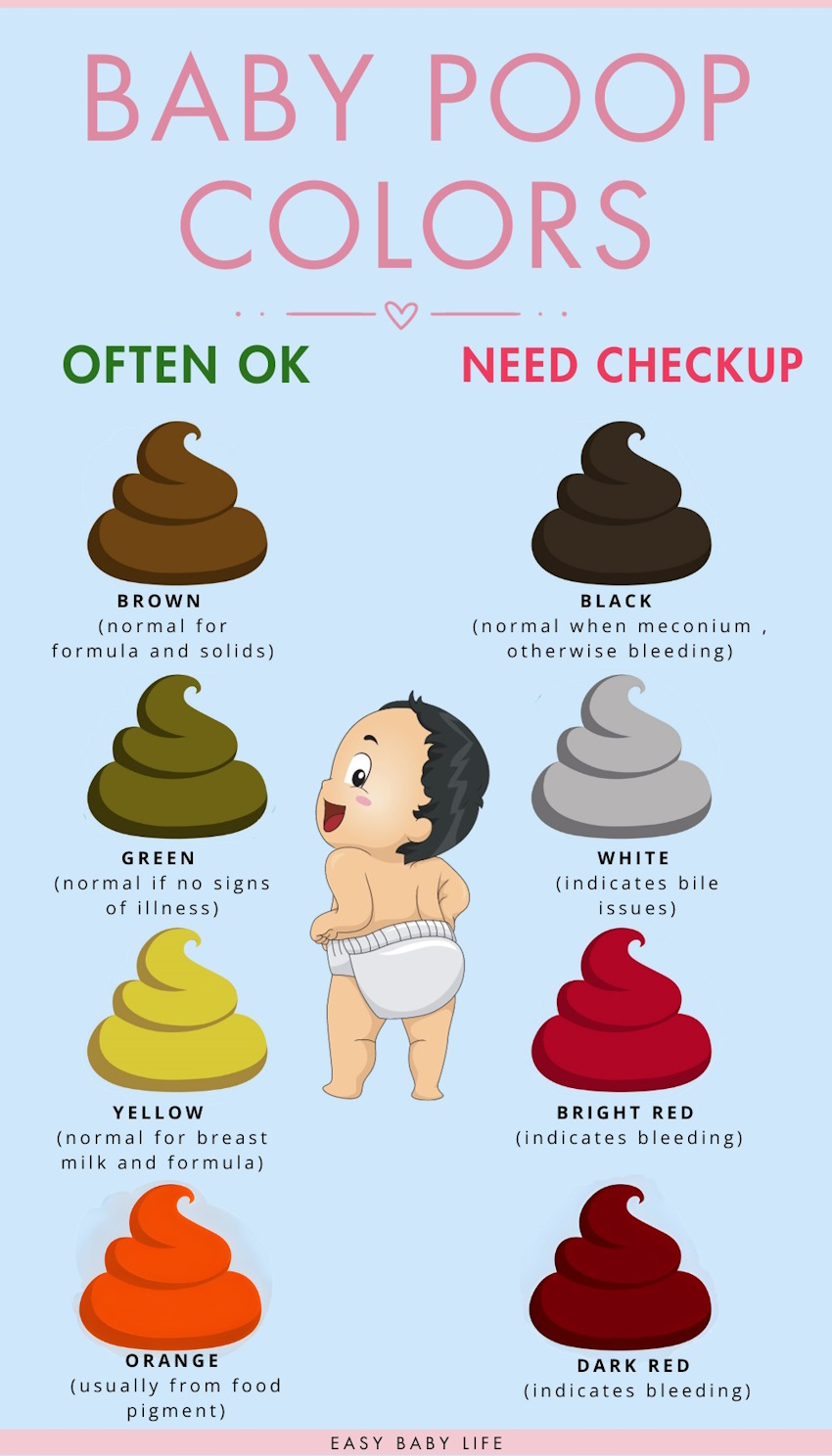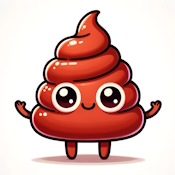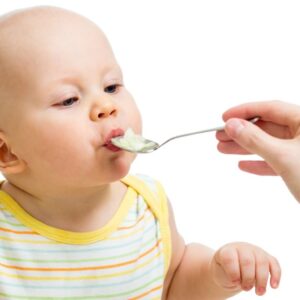Welcome to the colorful world of baby poop! It’s not just about dirty diapers; it’s a window into your baby’s health.
From mustard yellow to green, brown, red, black, white, and orange, each hue has its own explanation, as you can see in the baby stool color chart below.

This article will walk you through the spectrum of poop colors in breastfed and formula-fed babies and in those starting with solid foods. Learn what’s normal, what could be a cause for concern, and when to consult your pediatrician.
Yellow Baby Poop
Let’s start with the most common color for babies that have yet to start with solid foods – yellow. Yellow baby poop is normal and expected. If the color is very pale yellow – almost white – it could indicate a problem, and you should read about white and clay-colored poop below. As long as that baby mainly eats breast milk or formula, yellow baby poop is expected. The exact color and consistency can vary though.
Breastfed Babies
Yellow, mushy bowel movements are expected for breastfed babies. The yellow comes as the baby begins digesting breast milk, transitioning from the initial meconium. These bowel movements are usually seedy and loose, resembling light mustard.
Formula-fed Babies
In formula-fed babies, the bowel movements might be yellow, orange, tan, green, or gray. These stools may be a liquid texture, or slightly firmer than those of breastfed babies but still with a soft consistency. Think of formed stools as like a Play-Doh texture.
Green Baby Poop
Green poop looks really odd the first time you see it! However, it is actually often a normal variation for breastfed and formula-fed babies unless associated with illness. There are several reasons for the color:
Digestive Process and Speed
Green poop may indicate that the stool moved through the intestines quickly, and, therefore, has less bile pigment. This rapid transit can occur in cases of diarrhea, where the stool is often green rather than brownish.
Diet
Breastfed Babies: Green poop in breastfed babies is often a normal variation. However, if the poop is bright green and frothy, the baby may have lactose overload or lactose intolerance (rare in infants). Lactose overload may also lead to a very fussy baby and explosive poop. Oversupply is a common reason for lactose overload, and you may want to discuss the situation with a lactation consultant. The breastfed baby’s poop can also turn green if the mom takes iron supplements.
Formula-fed Babies: For formula-fed babies, tannish green poop is quite common, mainly because the components of the formula are different from breastmilk.
Transitioning Stages: When a baby starts eating solids, their poop can turn green due to the introduction of new foods into their diet.
Teething
Some parents notice that their baby’s poop turns green during teething. This is thought to be due to the increased amount of saliva that is swallowed.
Illness
Babies who have a bacterial or viral infection, like a cold or stomach flu, can have green stools.
Food Intolerance
Babies can be sensitive to foods in the mother’s diet or their own once they start solids. A green stool with a mucus-like texture could indicate an intolerance to something the baby or the breastfeeding mother has eaten.
Meconium
Another type of green is newborns’ very dark-green first bowel movements, known as meconium. Learn more about meconium under the heading Black Poop.

Brown Baby Poop
Brown baby poop is a common and normal color, especially as babies grow older and start eating a more varied diet. Here are some reasons behind the brown color in baby poop:
Diet
Formula Feeding: Formula-fed babies often have poop that is a bit darker, ranging from yellow to brown. The consistency is usually thicker than that of breastfed babies, resembling peanut butter.
Introduction of Solid Foods: As babies start eating pureed foods, their poop tends to become more solid and brown. This change is due to the digestive system breaking down a wider variety of foods. The introduction of new foods can also influence the exact shade of brown in the poop.
Digestive Process Maturing
As a baby’s digestive system matures, the poop becomes more formed and takes on a more typical brown color seen in older children and adults. This is a normal part of development.

Orange Baby Poop
Orange baby poop, though less common than other colors, is generally considered normal and can be influenced by various factors:
Diet
The most common reason for orange-colored stool in babies is the consumption of orange foods like carrots or apricots. The pigments in these foods can pass through the baby’s digestive system and color the stool.
Breastfeeding
The diet of breastfeeding mothers can also affect the color of a baby’s stool. If a mother consumes foods containing orange food dyes or is on medication (e.g., antibiotics), this could lead to the baby having bright orange poop.

Black Baby Poop
Black baby poop can indicate different things depending on the age of the baby (or toddler):
Newborns (Meconium)
A newborn’s first stool, known as meconium, is typically black or dark green and tar-like. Meconium comprises materials the baby swallowed while still in the womb, such as amniotic fluid, mucus, intestinal epithelial cells, lanugo hair, bile, and (mostly) water. (Yum!.) This type of black poop is completely normal and expected.
After the Newborn Period
If a baby older than a few days continues to have black stools or if the baby’s stool turns black after having transitioned to normal yellow, green, or brown poops, it could be a sign of a medical concern.
Gastrointestinal bleeding
One of the more serious reasons for black poop in babies is gastrointestinal bleeding. It is very uncommon in infants. in such cases, the black color is often due to the presence of blood that has been digested when passing through the baby’s digestive system. This process turns the blood black, giving the stool a tarry appearance. It’s crucial to note that gastrointestinal bleeding requires immediate medical attention, as it can indicate various underlying health issues.
Diet
The black poop may be related taking iron supplements if the baby has been diagnosed with anemia. Still, due to potentially serious reasons, you should always consult a doctor immediately if you notice black poop in your baby’s diaper.

White or Clay-Colored Baby Poop
White or clay-colored baby poop is a cause for concern, as it often indicates a lack of bile (a fluid that helps digestion). Bile contains pigments, such as bilirubin, which are by-products of the breakdown of red blood cells. These pigments undergo chemical changes in the intestines and contribute to the yellow or brown color of normal stool.
If bile is not entering the intestines due to a blockage of the bile ducts or liver problems, the stool lacks these pigments and thus does not obtain the typical brown color. Instead, it appears white or clay-colored.
Here are some potential explanations:
Liver or Gallbladder Issues
The most common reason for white or clay-colored stools in babies is a problem with the liver or gallbladder, as these areas are where bile is released and stored. This can include conditions like biliary atresia, where the bile ducts are blocked or absent.
Medications or Supplements
Certain medications or supplements, particularly those containing aluminum hydroxide, can cause lighter stools. However, aluminum hydroxide is not recommended for infants because it is neurotoxic and can damage the growing bones.
Infections and intestinal issues
Some viral infections can temporarily affect the liver’s ability to produce bile or something is causing a blockage, resulting in pale stools.
Dietary Causes
In rare cases, light-colored stools might be due to a baby’s diet. If so, it is usually only one or two stools that are light in color before normal colored stools resume. However, due to the possibly severe reasons for white poop, you should not assume this to be the case.
If you notice that your baby’s poop is white or clay-colored, it’s essential to consult a pediatrician. They can conduct appropriate tests to diagnose the underlying cause and provide the necessary treatment.
Red Baby Poop
Red poop can undoubtedly be alarming as it may be due to intestinal bleeding. It can, however, also be due to unproblematic reasons, such as diet or medication. The shade of red matters, too. If bleeding is involved, the shade of the poop – bright and dark red – is a clue to where the blood comes from; the lower or upper gastrointestinal tract.
Bright Red Poop
Bright red poop is often due to bleeding in the lower gastrointestinal tract. The most common cause is a cow’s milk protein allergy, but other food allergies may cause this as well.
Anal fissures: It can be caused by anal fissures, which are small tears around the anus that can occur in infants due to hard stools or constipation. Anal fissures are one of the most common reasons for blood in babies’ stools.
Intestinal Bleeding: Larger amounts of bright red blood in a baby’s stool may indicate a problem in the lower part of the intestines, suggesting some form of digestive system abnormality.
Diet: Another cause could be the ingestion of red-colored foods or drinks, which can harmlessly stain the stool.
Medications: Certain medicines can also cause red stool. In these cases, the red color is not due to blood.
Cow’s Milk Colitis: In infants, an allergy or sensitivity to cow’s milk can lead to colitis, which may cause loose, slimy stools that can be blood-streaked. This usually starts within the first two months of life and requires avoiding cow’s milk formulas.
Infections: If the baby is unwell and has diarrhea mixed with red blood, a bacterial infection could be the cause. Infections such as those caused by Shigella, Salmonella, E.Coli 0157, or Campylobacter can lead to bloody diarrhea.
Dark Red Poop
Dark red poop can indicate bleeding in the upper gastrointestinal tract.
Ulcers: This type of bleeding might stem from more severe conditions, such as a stomach or intestinal ulcer. Babies do not typically develop this condition.
Intussusception: Another serious condition seen in toddlers that may present with dark red blood is intussusception. Part of the intestine slides into an adjacent segment of the intestine, which can cause stools to resemble dark red jelly. This condition is serious and requires surgical intervention.
Swallowing blood: A less concerning reason for dark red poop is swallowing blood, for example, from their mother’s nipples while breastfeeding. This can happen if the mother has cracked or bleeding nipples.
Diet and infections: Finally, just like with brighter red-colored poop, infections, indigestion of certain foods and food colorings, and medicine can lead to dark red poop.
No matter the shade of red, it’s essential to consult with a pediatrician to determine the cause of the color change and to rule out any severe conditions.
When to Worry

Certain baby poop colors: If your baby’s bowel movements are still black several days after birth or suddenly turn black, red or bloody, or white, it’s essential to consult a healthcare provider.
Consistency and Frequency: Diarrhea or constipation can be a concern. Diarrhea in babies can lead to dehydration, while constipation might indicate dehydration.
Accompanying Symptoms: If unusual stool color is accompanied by fever, vomiting, lethargy, or irritability, you should consult a doctor.
Sudden Changes: Sudden changes in stool color, especially if accompanied by changes in behavior or health, should also be discussed with a pediatrician.
Takeaway on Baby Poop Colors
Remember, the occasional odd-colored poop is usually nothing to worry about, especially if your baby seems healthy otherwise. However, if you’re ever in doubt, it’s best to consult with your pediatrician for advice specific to your child’s health and circumstances.
Black, white, and red baby poop should always be discussed with your baby’s healthcare provider.
Read Next
- Blood In A Baby’s Diaper: 10 Important Reasons to Check
- My Baby is Urinating Blood! Important Reasons and What to Do
- 5 Reasons For Blood in a Baby’s Poop and The Blood Color Facts
- Bottle-fed Baby In Pain While Feeding And Dark Green Poop
References
- Healthy Children: Unusual Stool Colors
- Breastfeeding.au: Lactose Overload
- CHOC.org: Your Child’s Poop – An Ultimate Guide
- Cleveland Clinic: The Color of Baby Poop And What It Means
- SeattleChildren. org: Unusual Stool Color

Paula Dennholt founded Easy Baby Life in 2006 and has been a passionate parenting and pregnancy writer since then. Her parenting approach and writing are based on studies in cognitive-behavioral models and therapy for children and her experience as a mother and stepmother. Life as a parent has convinced her of how crucial it is to put relationships before rules. She strongly believes in positive parenting and a science-based approach.
Paula cooperates with a team of pediatricians who assist in reviewing and writing articles.









